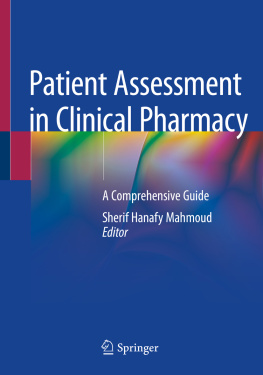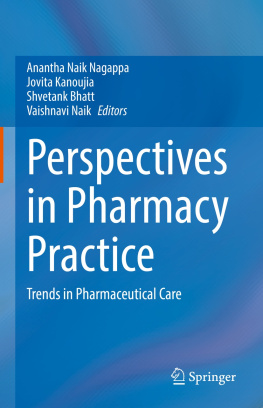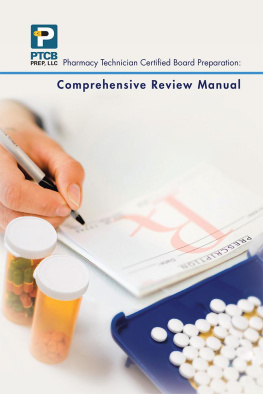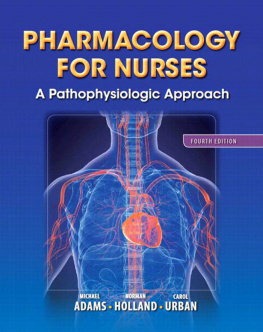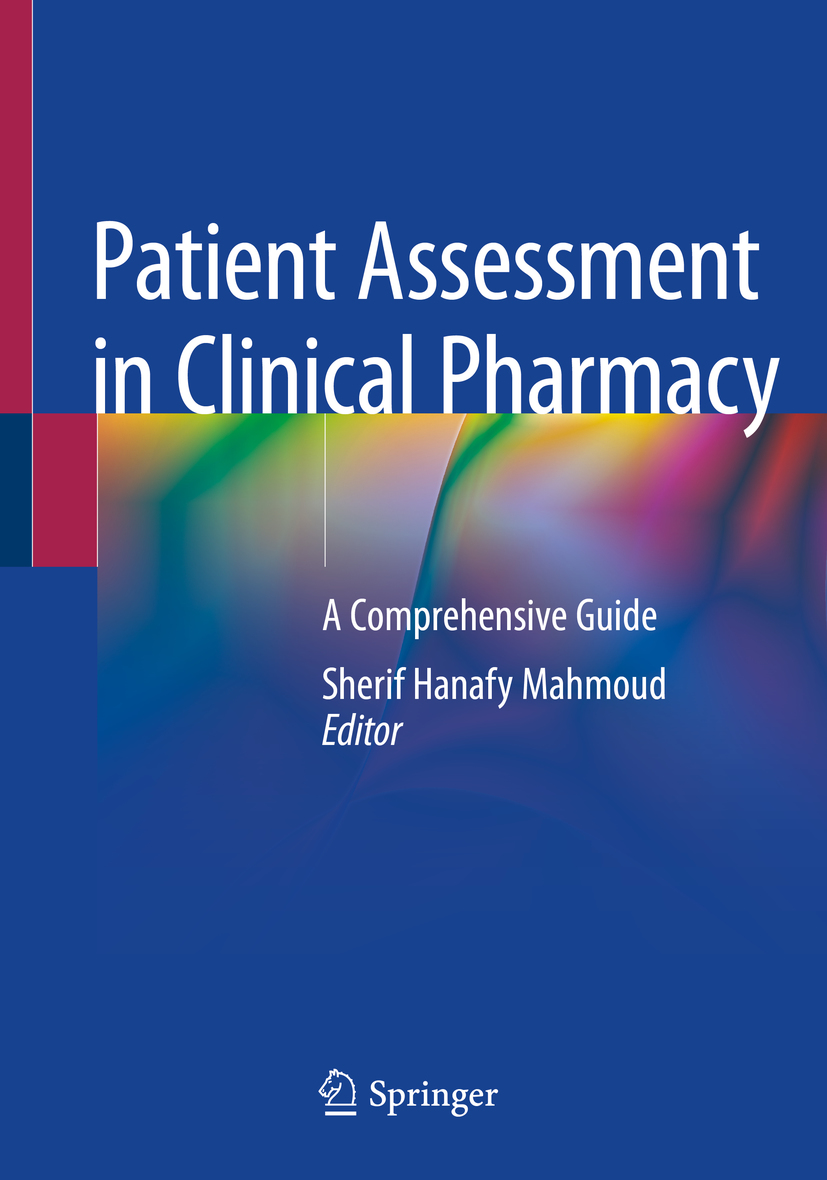Editor
Sherif Hanafy Mahmoud
Patient Assessment in Clinical Pharmacy A Comprehensive Guide
Editor
Sherif Hanafy Mahmoud
Pharmacy and Pharmaceutical Sciences, University of Alberta, Edmonton, AB, Canada
ISBN 978-3-030-11774-0 e-ISBN 978-3-030-11775-7
https://doi.org/10.1007/978-3-030-11775-7
Library of Congress Control Number: 2019936364
Springer Nature Switzerland AG 2019
This work is subject to copyright. All rights are reserved by the Publisher, whether the whole or part of the material is concerned, specifically the rights of translation, reprinting, reuse of illustrations, recitation, broadcasting, reproduction on microfilms or in any other physical way, and transmission or information storage and retrieval, electronic adaptation, computer software, or by similar or dissimilar methodology now known or hereafter developed.
The use of general descriptive names, registered names, trademarks, service marks, etc. in this publication does not imply, even in the absence of a specific statement, that such names are exempt from the relevant protective laws and regulations and therefore free for general use.
The publisher, the authors, and the editors are safe to assume that the advice and information in this book are believed to be true and accurate at the date of publication. Neither the publisher nor the authors or the editors give a warranty, express or implied, with respect to the material contained herein or for any errors or omissions that may have been made. The publisher remains neutral with regard to jurisdictional claims in published maps and institutional affiliations.
This Springer imprint is published by the registered company Springer Nature Switzerland AG
The registered company address is: Gewerbestrasse 11, 6330 Cham, Switzerland
For my wonderful wife, Sally, who is always supportive of my crazy endeavors
For my precious kids, Basant, Omar, and Ali, for being the pearls of my life
For every pharmacist, who strives to make life better for their patients
Foreword
The educational training and the role of pharmacists as medication expert healthcare professionals for patient-centered care in the twenty-first century require comprehensive patient assessment. One of the most important skill sets a pharmacist will use in clinical practice is patient assessment. An important aspect of pharmacy practice is effective communication and taking both clinical and scientific information and translating that for patients. Pharmacists work both independently and in teams, and they are professionals who effectively communicate and have a passion for enquiry and seek to understand patients holistically. Canadian pharmacists are some of the greatest luminaries and innovators in the pharmacy profession, and the practice of pharmacy in Alberta has often led the way.
Patient Assessment in Clinical Pharmacy: A Comprehensive Guide is divided into four parts:
Part I. The three introductory chapters provide a foundation of the patient care process and set forth the principles of patient and physical assessment to be followed.
Part II. Symptoms assessment is divided into eight succinct chapters of mental and physical features that may indicate a disease or condition and particular features that are often apparent in assessment of patients by pharmacist clinicians. As pharmacists routinely diagnose and treat common illnesses and refer their patients when required, the highlighted symptomology in this guide can be a sign of an undesirable manifestation, adverse effects, or existence of disease in a patient requiring further follow-up.
Part III. Chronic illness assessment is discussed in a series of ten chapters reflecting some of the major diseases that are often managed by pharmacists independently and in teams involving various body systems including endocrine, cardiovascular, pulmonary, neurology, and musculoskeletal. The pharmacists role in chronic disease management and self-care is of paramount importance to optimal health outcomes.
Part IV. Specialized assessments are a clinical cornerstone of pharmacy practice, and this section reflects nine areas involving laboratory testing and clinical practice beginning with pharmacokinetic assessment of drug disposition for drug monitoring, extending to laboratory value and biomarker assessment of major organ systems as well as chemical pathology, hematology, blood gases and coagulation, microbiology and immunology, and an overall understanding and interpretation of clinical biochemistry and assorted diagnostics.
Overall, this guidebook is a reference for pharmacist practice designed for and by pharmacists to augment existing knowledge and skills and to optimize practice and is a welcomed addition to a paucity of focused literature on this subject. This textbook is intended to fill the significant educational apertures in patient assessment that are contemporarily required by pharmacists and educators to provide primary care patient-centered pharmacy services. This textbook further reflects current Canadian pharmacy practice guidelines where applicable and extends them where necessary and prudent. This is a seminal Canadian-authored reference patient assessment book that is intended for a global audience. The potential of this guide to be adopted by pharmacy schools and pharmacists as well as other healthcare professionals is indicative of its quality and the caliber of the pharmacy practitioners and academics in Alberta and throughout Canada and their erudite insights into medication expertise for patient-centered care.
Neal M. Davies
Preface
Pharmacists role as healthcare practitioners is evolving as they are taking a more active part in primary patient care. Clinical services are now becoming the forefront of pharmacy practice as pharmacists are helping patients manage their medications and diseases, providing patient education and, in some jurisdictions, prescribing and adapting medications. As medication experts, pharmacists interventions in patients care have been shown to improve patient outcomes and reduce healthcare costs in various practice settings. In order to perform their day-to-day duties, pharmacists need a framework to guide care for their patients. This framework is called the patient care process, and it involves three main steps: patient assessment, care plan development, and implementation and monitoring and follow-up. An essential part of the patient care process in addressing patient concerns is complete patient assessment. Patient assessment skills apply to all pharmacy practice settings, including community, hospital, and specialized pharmacy practice. The importance of patient assessment skills together with the scarcity of resources in this topic initiated the idea of this book. The aim of this book is to provide a comprehensive discussion of patient assessment for clinical pharmacists. It is organized into four parts. Part I includes introductory chapters regarding the basics of patient assessment and components of the patient care process. Part II includes a detailed assessment of common symptoms encountered by pharmacists in their practice. Part III discusses assessment of patients with various chronic illnesses. This is followed by Part IV, which addresses select specialized topics and assessment considerations of interest to pharmacists such as pharmacokinetic assessment, critical illness assessment, and assessment considerations in older adults and pediatric patients. This book targets all pharmacists, regardless of their practice setting, and pharmacy students, serving as a valuable tool and resource in their daily practice.

